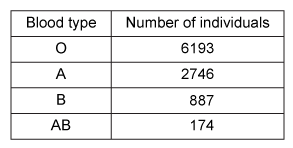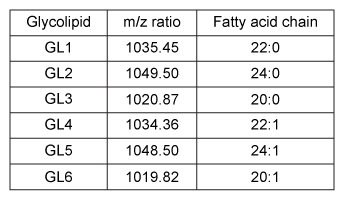Passage
The ABO blood groups are determined by the polysaccharide antigens linked to sphingolipids on red blood cell membranes. The polysaccharide known as the H-antigen (O-type blood) consists of a polysaccharide (R-group) glycosidically linked to D-galactose, which is connected to L-fucose in an α-1,2 linkage. Type A and type B blood express the A- and B-antigens, respectively (Figure 1) . These antigens are modified forms of the H-antigen, in which D-galactose (B-antigen) or a derivative of D-galactose called GalNAc (A-antigen) is added in an α-1,3 linkage to the D-galactose moiety of the H-antigen.
 Figure 1 Structures of the H-, A-, and B-antigens. The R-group represents additional carbohydrates.The addition of GalNAc or galactose to the H-antigen is catalyzed by an enzyme encoded by the ABO gene. One allele of the gene encodes GalNAcyl transferase and produces the A-antigen, while another allele encodes galactosyl-transferase and yields the B-antigen (Figure 1) . The two alleles differ at seven nucleotide positions, summarized in Table 1.Table 1 Nucleotide Positions Where the Alleles Encoding GalNAcyl Transferase and Galactosyl Transferase Differ
Figure 1 Structures of the H-, A-, and B-antigens. The R-group represents additional carbohydrates.The addition of GalNAc or galactose to the H-antigen is catalyzed by an enzyme encoded by the ABO gene. One allele of the gene encodes GalNAcyl transferase and produces the A-antigen, while another allele encodes galactosyl-transferase and yields the B-antigen (Figure 1) . The two alleles differ at seven nucleotide positions, summarized in Table 1.Table 1 Nucleotide Positions Where the Alleles Encoding GalNAcyl Transferase and Galactosyl Transferase Differ
 Individuals with both alleles express both antigens and have type AB blood. Those with type O blood have a third allele that encodes an inactive form of the enzyme. A study of blood type abundance was conducted, and the number of participants with each type is shown in Table 2. Table 3 shows several fatty-acyl chains found in the sphingolipids to which the antigens were attached.Table 2 Number of Participants That Express Each Blood Type in a Study of 10,000 Individuals
Individuals with both alleles express both antigens and have type AB blood. Those with type O blood have a third allele that encodes an inactive form of the enzyme. A study of blood type abundance was conducted, and the number of participants with each type is shown in Table 2. Table 3 shows several fatty-acyl chains found in the sphingolipids to which the antigens were attached.Table 2 Number of Participants That Express Each Blood Type in a Study of 10,000 Individuals
 Table 3 Types of Sphingolipids to Which Polysaccharide Antigens Were Bound, as Determined by Mass Spectrometry (Note: For fatty acid chains, the numbers on the left and right of the colon indicate number of carbons and number of C=C double bonds, respectively)
Table 3 Types of Sphingolipids to Which Polysaccharide Antigens Were Bound, as Determined by Mass Spectrometry (Note: For fatty acid chains, the numbers on the left and right of the colon indicate number of carbons and number of C=C double bonds, respectively)

-Which of the following statements accurately describes the sphingolipids in Table 3?They provide structure to biological membranesThey are primarily used for energy storageThey can be hydrolyzed to produce two fatty acids
A) I only
B) III only
C) I and II only
D) II and III only
Correct Answer:
Verified
Q223: Passage
Physical activity produces an increased energy requirement
Q224: Passage
The ABO blood groups are determined by
Q225: Passage
The ABO blood groups are determined by
Q226: Passage
Physical activity produces an increased energy requirement
Q227: The physical properties of two isoforms of
Q229: An enzyme was assessed for its ability
Q230: Passage
Physical activity produces an increased energy requirement
Q231: Passage
Many cephalopods can change color to blend
Q232: Passage
The ABO blood groups are determined by
Q233: Passage
The ABO blood groups are determined by
Unlock this Answer For Free Now!
View this answer and more for free by performing one of the following actions

Scan the QR code to install the App and get 2 free unlocks

Unlock quizzes for free by uploading documents